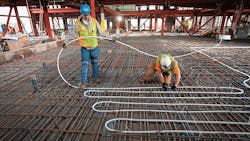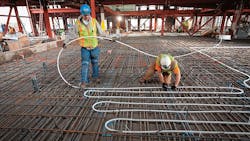“Dave, we recently installed a new concrete ramp and sidewalk for a two-bay fire house. We placed PEX tubing in the area before pouring the concrete for melting snow and ice. Would you be willing to give us a price on connecting this to the existing boiler? The prices we’ve gotten so far range all over the map. The highest ones are way outta line.”
The general contractor’s foreman is a good guy. I’ve known him for a long time. Was there any insulation under the slab? “No.” How many loops? “Nine.” How far apart are the tubes? “Twelve inches on centers and an average of 2 inches below the 9-in. thick concrete.” A jobsite visit was arranged, so that I could reverse engineer the system required to meet the expectations of a snow/ice-free ramp/sidewalk area for the paid firefighters.
I am indebted to the Radiant Professionals Alliance (RPA) for the training that enables me to provide professional designs and installations for hydronic and electric snow-melt systems. Hitch that wagonload of knowledge up to the Uponor snow-melt design program, and I am confident the finished product will easily meet the customer’s stated wishes. It also grants you the ability to determine if a partially installed system will be able to meet expectations.
First step: measure the snow-melt area, which was 1,910-sq.ft. Next step: visit the interior to examine the PEX loops and the existing boiler. Instead of nine loops, there were just five loops of ¾-in. potable PEX. They were not labeled, so no idea which ones go together, although that’s no more difficult than purging one line at a time with air or water to find its mate. The cast iron boiler has an 180,000-BTUH net output. PEX also has feet of tubing listed on the tubing, but the leader lengths were too short for footage to be seen on all the ends.
Potable PEX means there is no oxygen barrier. A heat exchanger and stainless steel or bronze circulator would be required on the snow-melt side. A 9-in. thick slab with tubing located 2-in. below the surface raises a concern under normal circumstances, but the GC on this job does their own concrete work and had installed the tubing, so if it was damaged via saw-cut joints, the costs would be theirs to bear. Normal saw-cut depth is 1/4th of the slab’s thickness, which would have been 2.25-in. deep.
If you are installing hydronic or electric radiant or snow-melt systems, communication is an essential element and the system installer cannot assume the concrete crews will be aware of your tubing/wire depth or location. Diving down to a safe depth at predetermined saw-cut or control joints is the only way to protect your work. It’s also a good idea to protect PEX with corrugated slit plastic conduit (like you see under the hood of your truck for bundling wires) where you know the concrete is going to crack.
Why would previous prices be all over the map? At first glance, this doesn’t look like a big deal. Add two manifolds for supply/return; pipe it across the basement to the boiler; fill up the system with at least a 30% glycol solution and take the money. End of story? Hardly.
My Uponor design program revealed a ton of information. The parameters were out-of-bounds, which required I go into the advanced design sections to bend several guidelines to near break-points because the program flags you for issues likely to cause problems.
The cast iron boiler has a net output of 180,000-Btuh. This is a fairly large two-bay firehouse and upon returning from a fire in winter, that’s many tons of frozen steel and hardware to warm. Even if the boiler were oversized by as much as 50%, turning on a large snow-melt system would have the potential to drag down the hydronic water temperature well into sustained flue-gas-condensation range, which would stress the boiler and lead to severe internal corrosion.
The Uponor design program revealed the snow-melt load was well in excess of 200,000-Btuh. The chimney isn’t large enough to accept a second boiler large enough to accommodate the snow-melt load (“just add a second boiler”).
Uponor’s design program also revealed a need for a circulator that could handle more than 60’ of head (resistance to flow) with a 30% glycol mixture at 23-GPM (gallons per minute). Add more glycol and the head loss increases. Potable tubing (no oxygen barrier) means all components on the snow-melt side must be non-ferrous. When selecting a circulator, you must account for the more viscous glycol solution. Fortunately, the Uponor design program does the math for you.
A large number of options would be available: none of them cheap. Reverse engineering clearly revealed that any low-ball bidders had not done their homework (if any at all). If the GC hires them to install the balance of system (BOS) components, those firemen may well be left inside in the cold while still having to shovel snow/ice off of their ramp and sidewalk. The firemen’s expectation (I asked) is that the snow will not accumulate — even during blizzard conditions.
All Dave Yates material in print and on Contractor's Website is protected by Copyright 2014. Any reuse of this material (print or electronic) must first have the expressed written permission of Dave Yates and Contractor magazine. Please contact via e-mail at: [email protected].
About the Author
Dave Yates
Dave Yates material in print and on Contractor’s Website is protected by Copyright 2017. Any reuse of this material (print or electronic) must first have the expressed written permission of Dave Yates and Contractor magazine.

